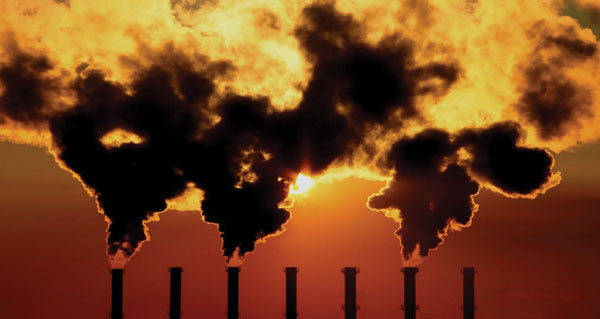Industrial activities play an important role in the economic well-being of a country contributing to sustainable growth. However, industrial activities also have a significant impact on the environment.
 |
| Industrial Sector Combustion Emissions, How to reduce and control? |
The largest industrial installations account for a considerable share of total emissions of key atmospheric pollutants and also have other important environmental impacts, including emissions to water and soil, generation of waste and the use of energy.
The greenhouse gases emitted during industrial production are divided into two categories.
• Direct emissions
• Indirect emissions
Direct emissions ??
Direct emissions are produced by burning fuel for power or heat, through chemical reactions, and from leaks from industrial processes or equipment. Most direct emissions come from the consumption of fossil fuels for energy. A smaller amount, roughly a third, come from leaks from natural gas and petroleum systems, the use of fuels in production (e.g., petroleum products used to make plastics), and chemical reactions during the production of chemicals, iron and steel, and cement.
Indirect Emissions??
Indirect emissions are produced by burning fossil fuel at a power plant to make electricity, which is then used by an industrial facility to power industrial buildings and machinery.
Emissions and Trends
In 2011, direct industrial greenhouse gas emissions accounted for approximately 20% of total U.S. greenhouse gas emissions, making it the third largest contributor to U.S. greenhouse gas emissions, after the Electricity and Transportation sectors. If both direct and indirect emissions associated with electricity use are included, industry\’s share of total U.S. greenhouse gas emissions in 2011 was 28%, making it the largest contributor of greenhouse gases of any sector.
Emissions from some Industrial Sectors in Pakistan
GHG emissions profiles for key industrial sectors are described here.
The emission estimates included in these initial industrial sector GHG profiles may be useful to a wide array of current public and private sector GHG inventory and reduction initiatives. Individual companies or industry groups could use this information as a reference for preparing more detailed GHG inventories and for designing effective GHG reduction strategies.
Cement Industry
The cement industry includes establishments primarily engaged in manufacturing straight portland, natural, masonry, pozzolanic, and other hydraulic cements.
Sources of Greenhouse Gas Emissions
Cement production results in CO2 emissions from on-site fossil fuel combustion, process-related noncombustion activities, and purchased electricity consumed in manufacturing operations.
The manufacturing of cement requires energy to operate manufacturing equipment and generate and maintain high kiln temperatures. This energy use results in direct emissions of carbon dioxide (CO2) from fossil fuel combustion and indirect CO2 emissions from purchased electricity.
Chemical Industry
The chemical sector, produces products by transforming organic and inorganic raw materials by a chemical process. Over 96% of all manufactured goods are directly impacted by chemistry, either as a material, in processing, or in some other value-added means.
Sources of Greenhouse Gas Emissions
The chemical sector depends on fuel inputs for energy and for raw materials (feedstocks).As such, GHG emissions from chemicals result from both the energy used by the industry as well as from the chemical processes themselves.
Construction Industry
The construction sector comprises establishments engaged in the construction of buildings and engineering projects.The work performed includes new work, additions, alterations, maintenance and repairs, and demolitions.
Sources of Greenhouse Gas Emissions
GHG emissions from the construction sector result from fuel consumed by on- and off-road construction equipment and from electricity consumed to provide power to construction tools and offices. Off-road diesel engines used by construction companies include a wide variety of loaders, dozers, excavators, graders, and other specialized equipment. Emissions from this sector are associated with energy use from construction, and do not include the post-construction performance of buildings.
Oil and Gas
The oil and gas sector, includes the exploration and production of petroleum and natural gas, processing of natural gas, the refining of petroleum and the non-combustion emissions from the transportation and distribution of oil and gas.
Sources of Greenhouse Gas Emissions
Oil and Gas Exploration, Production and Delivery Sub-Sector
There are two direct sources of GHG emissions (in the form of CO2) in the oil and gas production and delivery sub-sector:
• processes (considered non-combustion emissions)
• fossil fuel combustion.
Petroleum Refining Sub-Sector
The direct source of GHG emissions in the petroleum refining sub-sector is fossil-fuel combustion. The two largest fossil-fuel consuming processes in the petroleum refining industry are fluid heating and steam production. Fluid heaters are used in a variety of important refining steps such as distillation and pre-heating feedstock to induce reactions. Steam production is also considered to be a major refinery activity since substantial amounts of steam are used throughout a refinery.
Reducing Emissions from Industry
Understanding of combustion processes is fundamental to achieving further improvements in fuel use efficiency, reducing the production of pollutants such as nitrogen oxides, and easing the transition to alternative fuels. The goal of the Implementing Agreement on Energy Conservation and Emissions Reduction in Combustion is to accelerate the development of combustion technologies that demonstrate reduced fuel consumption and have lower pollutant emissions.
The focus on emissions is primarily concerned with toxic or noxious emissions, rather than greenhouse gases, although improved combustion efficiency will lead to a reduction in emissions of carbon dioxide.
The work programme includes:
• studies for improving the efficiency and fuel flexibility of automobile and truck engines
• improving the performance of industrial furnaces
• studies in emissions formation and control mechanisms and in fuel injection and fuel/air mixing
• investigations of the fundamental physical phenomena relevant to the combustion process
There are a wide variety of industrial activities that cause GHG emissions, and many opportunities to reduce them.
Energy Efficiency
How Emissions are Reduced
Upgrading to more efficient industrial technology.
EPA\’s ENERGY STAR® program helps industries become more energy efficient.
Example
Identifying the ways that manufacturers can use less energy to light and heat factories or to run equipment.
There are a wide variety of industrial activities that cause GHG emissions, and many opportunities to reduce them.
2. Fuel Switching
How Emissions are Reduced
Switching to fuels that result in less CO2emissions but the same amount of energy, when combusted.
Example
Using natural gas instead of coal to run machinery.
Awareness
How Emissions are Reduced
Making companies and workers aware of the steps to reduce or prevent emissions leaks from equipment.
Example
Instituting handling policies and procedures for perfluorocarbons (PFCs), hydrofluorocarbons (HFCs), and sulfur hexafluoride (SF6) that reduce occurrences accidental releases and leaks from containers and equipment
Keywords
Searches related to Industrial Sector Combustion Emissions
coal combustion emissions
diesel combustion emissions
propane combustion emissions
hydrogen combustion emissions
greenhouse gas emissions by source
greenhouse gas emissions by country
greenhouse gas emissions definition
global greenhouse gas emissions by sector


















